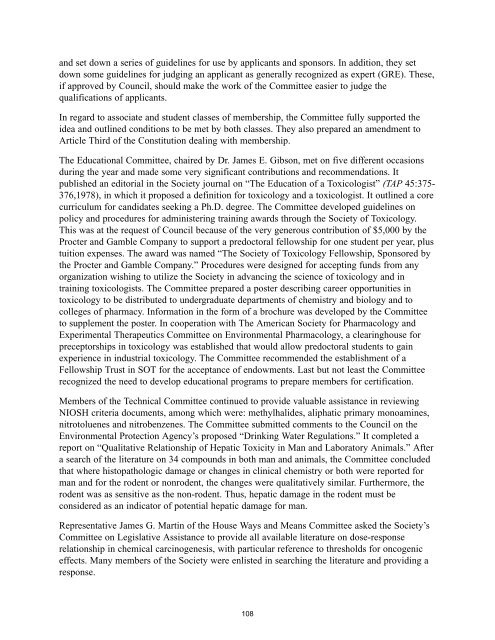SOCIETY O. TOXICOLOGY HISTORY - Society of Toxicology
SOCIETY O. TOXICOLOGY HISTORY - Society of Toxicology
SOCIETY O. TOXICOLOGY HISTORY - Society of Toxicology
Create successful ePaper yourself
Turn your PDF publications into a flip-book with our unique Google optimized e-Paper software.
and set down a series <strong>of</strong> guidelines for use by applicants and sponsors. In addition, they set<br />
down some guidelines for judging an applicant as generally recognized as expert (GRE). These,<br />
if approved by Council, should make the work <strong>of</strong> the Committee easier to judge the<br />
qualifications <strong>of</strong> applicants.<br />
In regard to associate and student classes <strong>of</strong> membership, the Committee fully supported the<br />
idea and outlined conditions to be met by both classes. They also prepared an amendment to<br />
Article Third <strong>of</strong> the Constitution dealing with membership.<br />
The Educational Committee, chaired by Dr. James E. Gibson, met on five different occasions<br />
during the year and made some very significant contributions and recommendations. It<br />
published an editorial in the <strong>Society</strong> journal on “The Education <strong>of</strong> a Toxicologist” (TAP 45:375-<br />
376,1978), in which it proposed a definition for toxicology and a toxicologist. It outlined a core<br />
curriculum for candidates seeking a Ph.D. degree. The Committee developed guidelines on<br />
policy and procedures for administering training awards through the <strong>Society</strong> <strong>of</strong> <strong>Toxicology</strong>.<br />
This was at the request <strong>of</strong> Council because <strong>of</strong> the very generous contribution <strong>of</strong> $5,000 by the<br />
Procter and Gamble Company to support a predoctoral fellowship for one student per year, plus<br />
tuition expenses. The award was named “The <strong>Society</strong> <strong>of</strong> <strong>Toxicology</strong> Fellowship, Sponsored by<br />
the Procter and Gamble Company.” Procedures were designed for accepting funds from any<br />
organization wishing to utilize the <strong>Society</strong> in advancing the science <strong>of</strong> toxicology and in<br />
training toxicologists. The Committee prepared a poster describing career opportunities in<br />
toxicology to be distributed to undergraduate departments <strong>of</strong> chemistry and biology and to<br />
colleges <strong>of</strong> pharmacy. Information in the form <strong>of</strong> a brochure was developed by the Committee<br />
to supplement the poster. In cooperation with The American <strong>Society</strong> for Pharmacology and<br />
Experimental Therapeutics Committee on Environmental Pharmacology, a clearinghouse for<br />
preceptorships in toxicology was established that would allow predoctoral students to gain<br />
experience in industrial toxicology. The Committee recommended the establishment <strong>of</strong> a<br />
Fellowship Trust in SOT for the acceptance <strong>of</strong> endowments. Last but not least the Committee<br />
recognized the need to develop educational programs to prepare members for certification.<br />
Members <strong>of</strong> the Technical Committee continued to provide valuable assistance in reviewing<br />
NIOSH criteria documents, among which were: methylhalides, aliphatic primary monoamines,<br />
nitrotoluenes and nitrobenzenes. The Committee submitted comments to the Council on the<br />
Environmental Protection Agency’s proposed “Drinking Water Regulations.” It completed a<br />
report on “Qualitative Relationship <strong>of</strong> Hepatic Toxicity in Man and Laboratory Animals.” After<br />
a search <strong>of</strong> the literature on 34 compounds in both man and animals, the Committee concluded<br />
that where histopathologic damage or changes in clinical chemistry or both were reported for<br />
man and for the rodent or nonrodent, the changes were qualitatively similar. Furthermore, the<br />
rodent was as sensitive as the non-rodent. Thus, hepatic damage in the rodent must be<br />
considered as an indicator <strong>of</strong> potential hepatic damage for man.<br />
Representative James G. Martin <strong>of</strong> the House Ways and Means Committee asked the <strong>Society</strong>’s<br />
Committee on Legislative Assistance to provide all available literature on dose-response<br />
relationship in chemical carcinogenesis, with particular reference to thresholds for oncogenic<br />
effects. Many members <strong>of</strong> the <strong>Society</strong> were enlisted in searching the literature and providing a<br />
response.<br />
108
















